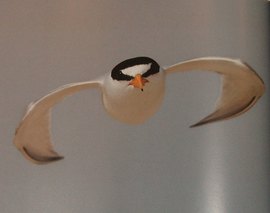Reviewed by Grant McCreary on May 14th, 2008.
I am not a bird photographer, although it is something I’d like to get into. But I know that you need some good equipment, skill, aesthetic sense, and sometimes just dumb luck. It is very difficult. And that’s just to get a good shot of a bird sitting still. But to photograph a bird in flight…I don’t know how photographers do it. Yet they do, and some spectacular evidence of it is collected in this book.
This book is unique in that every photograph features a bird in flight. Seven photographers contributed the approximately 175 photos included here. The images are universally sharp, well composed, and as far as I can tell, technically perfect. This is an amazing feat given the difficult subject matter. But it takes more than technical perfection to create a good, pleasing photograph. It also takes an intriguing subject, or an interesting behavior, or maybe the perfect framing of the subject against a dramatic background. It is this combination of the technical and artistic that causes viewers, upon first seeing a photograph, to react with a simple and understated “wow”. The majority of the pictures in this book produce such a reaction. There are a few that fall short, that seem to lack this extra quality. Some of the hawk photographs, for example, would be more at home in an identification guide, such as Hawks from Every Angle, than in this book of art. But for every one of those, there are many more that are simply stunning.
Most of these photos depict a single bird, but there are a few that have two birds of the same or different species. The ample layout and design of the large pages is excellent, maximally showcasing the photos with a large image size and, with only a few exceptions, presenting no more than one per page. Naturally, each photo needs a caption. Each of the captions here consists of:
- The scientific and common names of the species shown
- Habitat and Range of the species – 2 sentences or so
- The location of the photo (although some inexplicably lack this)
- A short paragraph, usually about the bird in general, or explaining behavior portrayed in the photo
The habitat and range information is a welcome inclusion. It is by no means comprehensive or detailed, but it will still be helpful to any reader unfamiliar with the species. The paragraph portion of the caption, however, does not work as well. It is most useful when used to explain something in the photograph, or to give some background to the shot. But otherwise, they just give some basic, general information about the species. Compared to the captions in Between the Wingtips, these are much less extensive and informative.
The author has organized the photographs into the following sections:
- Killers on the wing – raptors (including owls) – 32 species
- Wings along the shore – “shorebirds”, which includes the shorebird family as well as any bird that may be found along the shore or ocean, such as terns and puffins – 21 species
- Wings of the wetlands – 26 species
- Songbirds on the wing – 5 species, only three of which are actually passerines (Barn and Tree Swallows, and Eastern Meadowlark)
The first section is by far the largest, although that is to be expected since raptors are much easier to capture in flight (relatively speaking, of course). Raptor fans will have much to enjoy here. Personally, my biggest disappointment with this book is the dearth of songbirds. I know that these are the toughest to obtain, but I was really hoping that a ground-breaking book such as this would include a couple of warblers, tanagers, or the like. It also surprised me that there was only one shot of a hummingbird (a female Ruby-throated). Most of the subjects are North American birds, or those with a wide distribution, such as the Osprey. The remainder were taken in Australia, Israel, Hong Kong, and northern Europe.
The book’s introduction, as expected, explains the concept of the book. But it also presents some information on the focus of this book – avian flight. This primer, which includes the evolution and mechanisms of flight, migration, and other flight-related topics, is by necessity very shallow and basic. Still, it may be helpful to beginning or non-birders, and is a welcome inclusion.
As previously mentioned, my main issue with this book is the species selection. I wish there could have been a little more diversity. However, if the reason for this is a lack of suitable photographs, then that is understandable. Another issue I had was the inclusion of photographs of captive raptors. I must note that the birds are free-flying and unrestrained, and I would not have known that they were captive birds if the captions had not mentioned it. This is just my personal opinion, but to me this cheapens the photographs. They are just as technically and artistically excellent as any of the others in this book, but something has been lost. On first seeing one of the pictures here, a speeding Northern Goshawk, I marveled that the photographer was able to capture a bird that must have been speeding by so quickly. And never having seen the bird, I was jealous of the encounter. But on finding out that the bird was a captive, my feelings changed. Instead of a chance encounter with a difficult bird, all the photographer had to do was accompany a falconer who was flying the bird. Again, there is still skill involved in getting a great shot, but it no longer had the same impact to me.
There are also other, less subjective, problems. Some captions make statements about their subjects that are either confusing or outright false. Among North American owls, one caption says, the Barred is “most likely to be active during daylight hours”. But then a few pages later we read that the diurnal habits of the Burrowing Owl sets it apart from the rest of their kin. These statements seem mutually exclusive. The Barred can indeed be active during the day, but it is not known for this. The Burrowing, Snowy, Hawk, and pygmy owls are all probably more diurnal than the Barred. Another caption states that the Osprey is the “fastest-flying bird in the world”. However, this title is generally awarded to the Peregrine Falcon, as is actually mentioned earlier in the book. I’m not sure what the author intended to convey about the Osprey. Finally, the puffin is described as “among the more graceful birds in the air”. I have not seen many puffins in flight, but surely the author is not talking about the same birds that I saw. Puffins are known for many things, but grace in the air is not usually one of them.
There are also some curious omissions. There is virtually no technical information given about the photographs, and no mention at all of the equipment used to capture them. I’m sure that other photographers would have appreciated this information.
Recommendation
 The various issues with this volume are disappointing, but mostly insignificant. There is no denying that the photographs collected here are amazing, and in some cases startlingly unique. Check out any of the several photos of Bald Eagles and I’m sure you will agree. Or consider the unforgettable shot of a stooping American Kestrel filling the page. And then there is my favorite image – a Least Tern flying directly toward the lens, wings curled back, projecting such attitude and liveliness. Just this latter one alone is worth the cost of the book to me. Aficionados of bird photography will definitely want this unique book, and all bird lovers should appreciate it. Leave it sitting around the house and any non-birders who leaf through it just may be converted.
The various issues with this volume are disappointing, but mostly insignificant. There is no denying that the photographs collected here are amazing, and in some cases startlingly unique. Check out any of the several photos of Bald Eagles and I’m sure you will agree. Or consider the unforgettable shot of a stooping American Kestrel filling the page. And then there is my favorite image – a Least Tern flying directly toward the lens, wings curled back, projecting such attitude and liveliness. Just this latter one alone is worth the cost of the book to me. Aficionados of bird photography will definitely want this unique book, and all bird lovers should appreciate it. Leave it sitting around the house and any non-birders who leaf through it just may be converted.
Disclosure: I get a small commission for purchases made through links in this post.
Disclosure: The item reviewed here was a complementary review copy provided by the publisher. But the opinion expressed here is my own, it has not been influenced in any way.







 (4 votes, average: 3.50 out of 5)
(4 votes, average: 3.50 out of 5)
Comment